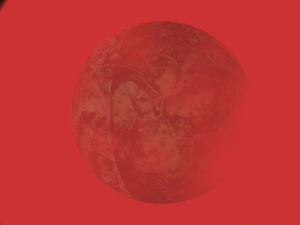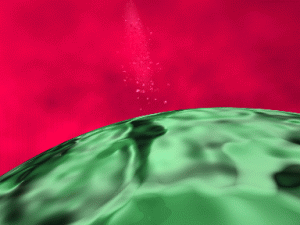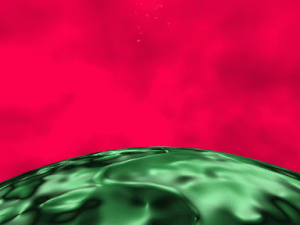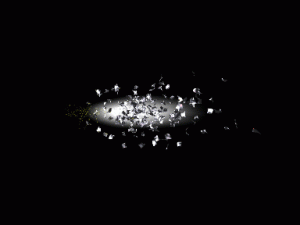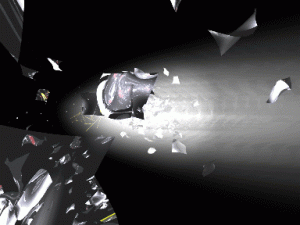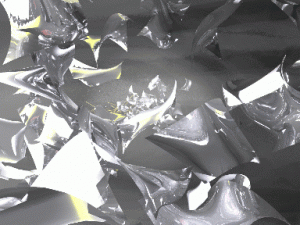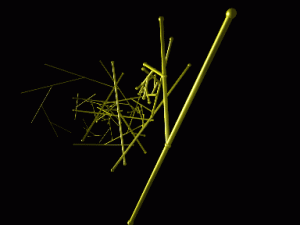Overview
Concrete Net from 1996-97 represents a continuation of my work with the animation of sound that began with When Timbre Comes Apart and Planet (Terra). However, whereas the two previous works were based on direct mapping of spectra, Concrete Net maps part of the fundamental idea for the music, but not its program content. Images and sounds were developed simultaneously, and the visual objects are directly linked to the sound objects.
Ideas
Norway is a country that is quite long and for the most part vertical, and farmers in the Western part of the country have come up with an ingenious means of transporting hay from the mountains down to their farms at the bottom of the valley in the fall in order to secure winter supplies for the animals during the cold season. They have mounted steel wires, frequently hundreds of meters long, which they use for sliding bales of hay right into their barns. These wires function in the same way as very long strings and have a terrific sound when excited.
A wire of this sort is a communication line: many wires form networks. And information sharing networks easily become barriers that both close in and shut out. Access to – and knowledge of – modern communication technology is rapidly becoming a significant segregating element in society.
The author J. G. Ballard’s novel Concrete Island (1973) deals with marginalization in contemporary society, which becomes cruel and difficult to defend oneself against if one happens to fall outside the spheres of normality, whether by coincidence or accident. In this book, Ballard describes a freeway system with a group of people, who although marooned in the freeway’s physical midst, are nonetheless without means of accessing this communication machine.
All of the above comprise a set of paradoxes that interests me, which I have coupled with a traditional compositional interest in the relationship between single events and larger structures (something which is shared with social sciences) in order to develop the material for this work. In practical terms, this was done through a set of ratios taken from our solar system; measurements of distances between the different planets. The distances to other planets varied depending on which planet was «home.» Since Pluto was too distant to give a large enough spread in distances to the other planets, I developed nine different sets of ratios after including the asteroid belt as a planet. Here, accuracy in astronomical terms has been less important than the development of a set of numbers from something physically existing that could be used for compositional purposes. The set of ratios was used for parametrization of both sound generation and processing, and to some extent for structural purposes of a higher order.
The form of the music is thought of as a short excerpt from a longer journey. Only the first six minutes contain external movement, where gestures and phrases are distinguishable on the surface of the music. There are several instances in the remainder of the piece where this material is repeated or referred to, but it has then become pulled into the texturally dense weave of complex spectra. There is significantly less dramatic movement in the images as well as the sound in this section, compared with the first part of the work, and the «camera» slowly performs a scan of the surroundings. The piece ends with a return to the same quiet with which it began – before alertness was provoked by the literal crash into the system of sounds that comprise the piece. «Concrete Net» maps the compositional idea to visual and aural domains, to musical parameters necessary for concentrated listening and time travel through sound.
Sound
The recorded sound sources are traffic noise, falling aluminum scrap pieces and voice from a reading of text fragments from Ballard’s book «Concrete Island.» The orchestral sounding glissandi results from granulated traffic noise, and the deep rumbling sounds as well. The parameter values in the granulation are rescaled and adjusted versions of the ratios mentioned above, and the granulations are executed in KYMA from Symbolic Sound. The bird-like sounds over the green planet under the pink sky are recorded voice sounds, spectrally separated through use of the same numbers, and mixing phrases from the recording. Executed in Ceres, NoTAM’s phase vocoder.
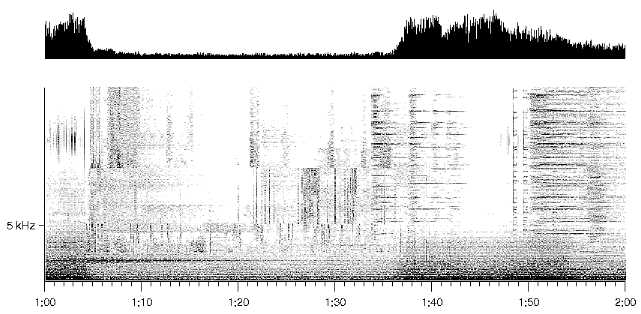
The floating cloud of space debris is represented through time-stretched and pitched versions of falling aluminum scraps, and the factors used stem from another reworking of the same ratios, also executed in Ceres, and mixed with Mix, NoTAM’s screen-based mixer for SGI.
There are nine different sets of golden strings, the string lengths having been determined by distances in the solar system. Visually, the strings rotate with slightly different speeds and angles. The sound results from physical modeling executed in the IRCAM program Modalys, and the strings are «welded» together almost at the center (~.58), so that the shortest string is connected the next-to-shortest string and so on. The strings are excited by recorded sections from Ballard’s book, spectrally separated (used earlier in the piece as «bird sounds»), with each slice exciting one string each. Each string in every set is excited by a different «sound slice,» and when one string is excited, all strings resonate. The output is quite a complex timbre, and the sonic result shares some characteristics with pre-digital spring reverbs, and relates in true fashion to the steel wires that can be heard in Western Norway.
Images
The images were all generated on SGIs using Povray, a shareware raytracing program. C-programs generate a description of form and the appearance of the three-dimensional objects, and these descriptions are sent to Povray, which calculates shadows, reflexes and ultimately renders the image. Colors and shapes are determined by subjective decisions based on aesthetics, and camera movement is linear with an even speed. The concert video thus appears to the viewer as a journey with only sounds and the objects associated to them present.
The generation of each image takes up to 12 hrs, depending on the complexity, and with 25 pictures/sec and a duration of 13 minutes, the computation time is considerable. The rendering has been running continually on three machines for months, with the material being dumped onto a SONY CRV disk in batches for final sync/mix with the music. Øyvind Hammer’s technical and aesthetic contribution to the animation process has been invaluable.
All pictures © Jøran Rudi
Not to be used for publication without permission.

